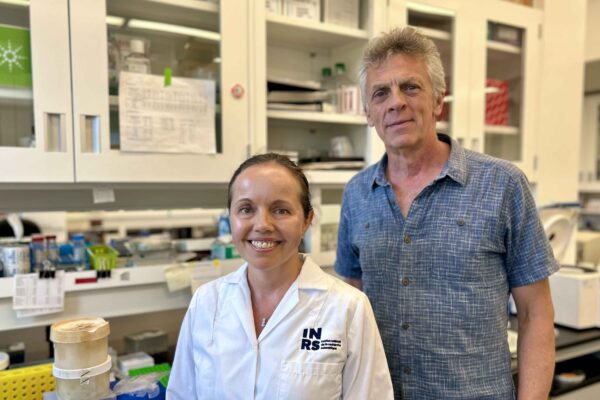- Research
-
YOU ARE
- Community member
- Future Student
- Student
- Professor
- Alumni
- Media
- Guidance counsellors
- INRS retiree
- Contact Us
- Newsroom
- Careers
- FR
-
Studies
We teach the next generation of researchers to develop scientific, social, and technological innovations.
-
Research
We find solutions through interdisciplinary research and industry or public and community partnerships.
-
INRS
We play an active role in Québec's economic, social, and cultural development.
A first philanthropic research chair on amyotrophic lateral sclerosis (ALS) is created thanks to a $1 million donation from the Manouk Djoukhadjian II Family Foundation to the Armand-Frappier Foundation.

This new research chair, Anna Sforza Djoukhadjian Philanthropic Chair, will be financed by an endowment fund, and led by Professor Kessen Patten, a researcher in genetics and neurodegenerative diseases at the Armand-Frappier Santé Biotechnologie Research Centre of the Institut national de la recherche scientifique (INRS). Professor Patten has been leading a recognized research program which aims at developing therapeutics for ALS, since 2015.
ALS, also known as Lou Gehrig’s or Charcot’s disease, affects more than 200,000 people worldwide, including 3,000 in Canada. It is an incurable neurodegenerative disease that attacks the neurons responsible for the proper functioning of muscles. ALS causes the progressive death of these motor neurons leading to loss of muscle use, paralysis and, ultimately, death.
“The drugs currently approved to slow the progression of ALS only have modest beneficial effects. But thanks to this major donation, we will be able to pursue our research in order to discover effective drugs that can be used by ALS patients to preserve or rescue their neurons and muscle movement,”
states Professor Patten.
« Ce financement nous permettra de jouer un rôle clé dans l’effort international visant à trouver un traitement pour la SLA », ajoute le chercheur qui collabore déjà avec des équipes à Montréal, dont l’Institut et hôpital neurologique de Montréal (Neuro), et en Californie.
“Such funding will allow us to play an active role in the global effort toward making ALS a treatable disease,” adds the scientist who already collaborates with a team in Montreal at the Montreal Neurological Institute & Hospital (The Neuro), and a team in California.
Professor Patten’s team at the INRS will conduct research on the development and use of the zebrafish model as well as motoneuron cell culture from diagnosed patients in order to better control the disease.

“Our aim is to identify potential therapeutic compounds through a method knows as phenotypic drug screening, and to translate these discoveries rapidly into human clinical trials,” explains Professor Patten.
The creation of the Anna Sforza Djoukhadjian Philanthropic Chair devoted to this disease, will allow the formulation of new studies devoted entirely to ALS, as well as the development of pharmaceuticals and treatments.
“I didn’t want this to happen to other families. This is why I decided to undertake a concrete project with the aim to slow down, stop and eventually eliminate this ruthless disease, says Mr. Manouk Djoukhadjian, whose wife died of the disease in 2018.The only way to achieve this goal is to support the research lead by devoted researchers who share our determination to tackle the beast.”
Every year, 1,000 Canadians will be diagnosed with ALS. Because there is still no cure, 80 per cent of people with ALS die within two to five years of diagnosis.1 In Canada, ALS is the most fatal neurological disease.
You may also like

January 27, 2020
Leishmania: A Parasite That Hijacks Our Cells’ Resources to Multiply
January 27, 2020
Protecting Immune Cells from ExhaustionShare

